|
BREAKER PANELS ORANGE COUNTY CA, BEST BREAKER PANELS ORANGE COUNTY
CA, ORANGE COUNTY BREAKER PANELS, ABOUT AN BREAKER PANEL,
BEST ELECTRICIAN ORANGE COUNTY CA, ELECTRIC PANEL UPGRADE, ELECTRIC
PANEL INSTALATION, BREAKER PANEL REPAIR, ELECTRIC PANEL REWIRE
|
|
Residential
Commerical
Industrial
|
BREAKER PANEL ORANGE COUNTY CA -
BEST BREAKER PANEL ORANGE COUNTY CA
JS ELECTRICAL CONTRACTOR ORANGE COUNTY CA
|
|
| |
(714)
469-2110
CALL
US TODAY!
|
|
BREAKER PANEL
|
|
| |
|
Electrician Orange County CA
- JS ELECTRIC -
Call Today
(714) 469-2110
VOTED BEST ELECTRICIANS IN ORANGE
COUNTY CA - Electricity Done Right!
Aliso Viejo, Irvine, Lake Forest, Rancho Santa Margarita, Laguna
Beach, Laguna Hills, Laguna Niguel, Trabucco Hills, Foothill
Ranch, Laguna Woods, San Juan Capistrano, Anahiem, Huntington
Beach, Newport Beach, San Clemente, Yorba Linda, Tustin, Buena
Park, Fountain Valley, Fullerton, Mission Viejo
"Invention is the most important product of man's creative
brain. The ultimate purpose is the complete mastery of mind
over the material world,
the harnessing of human nature to human needs." - Nikola
Tesla
|
|
|
| |
| . |
Electricians
Orange County
.com
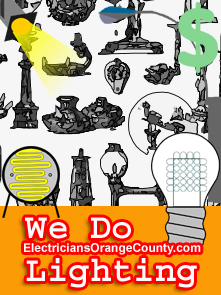
JS
Electric
We
are licensed 652382,
bonded, and insured
We accept Visa/Mastercard.
(714)
469-2110
CALL
US TODAY!
"Good
Power
Leads To Great Things!"
Greater
Living

(714)
469-2110
CALL
US TODAY!
VOTED
BEST
Electrician
In Orange County
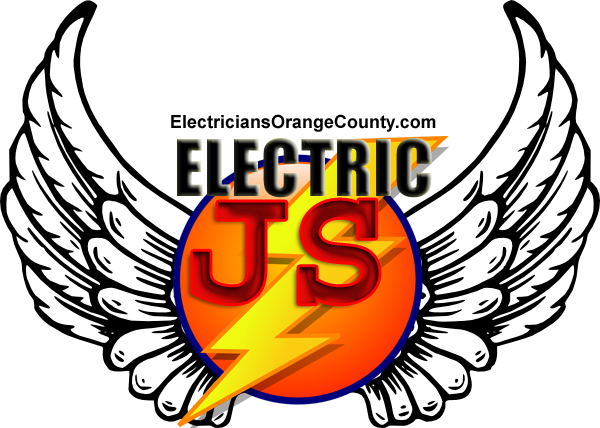
JS
Electric
We
are licensed 652382,
bonded, and insured
We accept Visa/Mastercard
(714)
469-2110
CALL
US TODAY!
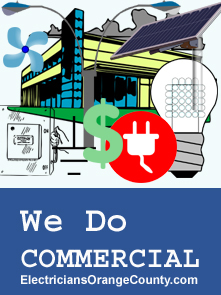
JS ELECTRIC
MISSION VIEJO
24112 Valyermo Drive
Mission Viejo, CA 92691
JS
ELECTRIC
SAN CLEMENTE
111 W. Avenida Palizada
San Clemente, CA 92672
JS
ELECTRIC
HUNTINGTON BEACH
19171 Magnolia Ave.
Huntington Beach, CA 92646
(714)
469-2110
CALL
US TODAY!
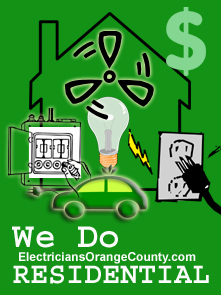
RECIPIE FOR LIFE
CALL
US TODAY
(714) 469-2110
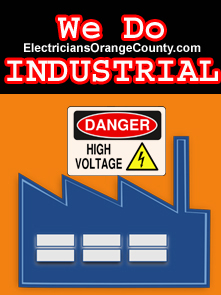
|
NOTE:
The
information and notices contained on this website
are intended as general research and information
and are expressly not intended, and should not
be regarded, as medical, financial or legal
advice. The articles are from free sources.
Our boutiques reserve the right to refuse service
to anyone. All of our lash artists have been
trained in eyelash extensions and conduct business
in a professional manner. A sales tax is included
in the amounts quoted/charged, some retail products
have not been taxed, you will pay this upon
purchase.
| |
|
MOST
PROFICIENT COMPANIES I HAVE SEEN!
JS Electric is one of the most responsive
and proficient electrician companies I
have seen. My experience with them has
is that they have demonstrated the knowledge
and experience to handle any electrical
issue for large, as well as smaller projects.
Plus, they are very responsive and provide
excellent customer service. I recommend
them highly.
|
|
|
|
|
. |
JS
Electric - ElectriciansOrangeCounty.com
- has been specializing in the BREAKER PANELS of homes,
commercial buildings, and industrial sites for OVER
25 YEARS.
We Upgrade ELECTRIC PANELS,
Rewire ELECTRIC PANELS, We Repair ELECTRIC PANELS,
and Install New ELECTRIC PANELS.
We're your premier electrical contractor because
we have exceptional service at fair market prices
and we answer the phone or
call you back within minutes. If you are
building new location, looking to purchase a whole
new electrical system, need a few outlets rewired,
electrical pannels installed, high voltage equipment
installed or your circuit breaker needs to be replaced,
we are here to help you.
WE
DO BREAKER PANEL EMERGENCIES
 VERY
PROFESSIONAL "Jim
and his crew are very professional, thorough, and helpful.
I had all my old halogens and containers replaced by
newer cntainers and LED bulbs in kitchen and living
room (high ceiling). They did a great job. Later, I
had new recessed lights with LED bulbs / containers
installed in all bedrooms. Wonderful job, good rewiring
from attic, nice clean drywall patchup, and good cleanup.
Overall excellent service. Good people to work with."
Bindu VERY
PROFESSIONAL "Jim
and his crew are very professional, thorough, and helpful.
I had all my old halogens and containers replaced by
newer cntainers and LED bulbs in kitchen and living
room (high ceiling). They did a great job. Later, I
had new recessed lights with LED bulbs / containers
installed in all bedrooms. Wonderful job, good rewiring
from attic, nice clean drywall patchup, and good cleanup.
Overall excellent service. Good people to work with."
Bindu
 "CONSISTENTLY
EXCEEDED THEIR EXPECTATIONS! "Jim
Smith is a professional, reliable and quality electrician.
Though I have quite thankfully not had to use him yet,
many of my business associates have. He has consistently
exceeded their expectations and delivered quality results.
I highly recommend Jim to all of my business associates
and to you." - Virginia, Irvine CA "CONSISTENTLY
EXCEEDED THEIR EXPECTATIONS! "Jim
Smith is a professional, reliable and quality electrician.
Though I have quite thankfully not had to use him yet,
many of my business associates have. He has consistently
exceeded their expectations and delivered quality results.
I highly recommend Jim to all of my business associates
and to you." - Virginia, Irvine CA
WHAT
MAKES US DIFFERENT?
Quick
Response TIME - If something electrical has stopped
working, you need it fixed FAST. We make every effort
to give service calls priority.
Skilled
Electricians - We are highly skilled at listening
to the customer and diagnosing electrical problems.
We know how to do electricity right!
FREE
ESTIMATES - YES our estimates are FREE.
We
are the professionals to call! -
We fully licensed, bonded and insured.
We do:
Troubleshooting
& Repairs Breaker & Fuse Repairs 277 Volt Commercial
Lighting Repairs & Installations Indoor / Outdoor
Lamps & Ballast Repairs Exit & Emergency Power Outage
lighting Restaurant Equipment Hook-ups Time Clocks
& Photo Cells 220 & 240 Volt Dedicated circuits Copiers,
Faxes and Computer circuits New Panels & Transformers
Property Managers & HOA service Code Violations &
Repairs Motor Control Circuits
We
Additonally offer Energy Efficient Lighting that
runs cooler, lasts longer, and offers a very high
percentage less energy usage that traditional lighting.
Call
Today, for your Free Comprehensive Facility Energy
Audit.
CALL
TODAY (714) 469-2110
ABOUT
BREAKER PANELS

A
fairly standard American circuit breaker
panel manufactured by General
Electric and using interchangeable
circuit breakers
A
distribution board (also known as
panelboard or breaker panel)
is a component of an electricity
supply system that divides an electrical
power feed into subsidiary circuits,
while providing a protective fuse
or circuit
breaker for each circuit in a common
enclosure.
Normally, a main switch,
and in recent boards, one or more residual-current
devices (RCD) or residual
current breakers with overcurrent protection
(RCBO), are also incorporated.
Other
names
Distribution
boards are also referred to as a:
- breaker
panel
- circuit
breaker panel
- consumer
unit, or CU
- electrical
panel
- fuseboard
- electric
board
- fusebox
- breaker
box
- load
centre/center
- panelboard
- power
breaker
- service
panel
- DB
board (South Africa)
- ACDB
(alternating current distribution board)
- DCDB
(direct current distribution board)
North
American boards
In
a North American distribution board, the
circuit
breakers are generally placed in two
columns. Circuit breaker panelboards are
always dead front, that is, the operator
of the circuit breakers cannot contact live
electrical parts. During servicing of the
distribution board itself, though, when
the cover has been removed and the cables
are visible, North American breaker panelboards
commonly have some live parts exposed.
Breaker
arrangement

Illustration
of breaker numbering in a North American
type panelboard. Some labels are missing,
and some lines have additional descriptive
labels. The numbers on the toggles
indicate the ampereage
they will pass before tripping off and
stopping all current. The top right
breaker (Rated at 100 A) leads to a
sub panel.
Breakers
are usually arranged in two columns. In
a US-style board, breaker positions are
numbered left-to-right, along each row from
top to bottom. This numbering system is
universal across various competing manufacturers
of breaker panels.
Each
row is fed from a different phase (A,
B, and C below), to allow
2- or 3-pole common-trip breakers to have
one pole on each phase. In North America,
it is common to wire large permanently installed
equipment line-to-line. This takes two slots
in the panel (two-pole) and gives a voltage
of 240 V if the supply system is split
phase and 208V if the supply system
is three
phase.
North American circuit breaker
numbering
| Split-phase |
3-phase |
Breakers |
| A |
A |
1 |
2 |
| B |
B |
3 |
4 |
| A |
C |
5 |
6 |
| B |
A |
7 |
8 |
| A |
B |
9 |
10 |
| B |
C |
11 |
12 |
Inside a North American panel

Electrical
panel and subpanel with cover removed
from subpanel.
The
picture to the right shows the interior
of a standard residential service, North
American General
Electric style breaker panel. The three
power wires - two hot and one neutral -
can be seen coming in at the top. The neutral
wire is connected to the neutral busbar
to the left with all the white wires, and
the other two are the hot wires attached
to the main breaker. Below it are the two
rows of circuit breakers with the circuits'
red and black hot wires leading off. Three
wires (hot black, neutral white, and bare
ground) can be seen directly exiting the
box and running to a NEMA
5-15 electrical
receptacle with a power
cord plugged into it. The incoming bare
stranded ground wire can be seen near the
bottom of the neutral bus bar.
The
picture on the left shows a North American
dual panel configuration. The main panel
(on the right with cover in place) and a
subpanel (on the left, with cover removed).
Notice that the subpanel is fed by two large
hot wires and a neutral wire running through
a small angled conduit. This configuration
appears to have three violations of the
current U.S. National Electric Code: the
main panel does not have a grounding conductor(here
it is fed into the subpanel instead), the
connection between the main and subpanel
does not have a grounding conductor (it
must use 4 instead of 3 wires), and the
subpanel neutral bar is bonded to the ground
bar (these should be separate bars after
the first service disconnect, which in this
case is the main panel).
|
|
Fuse
boxes

An
older style fuse box of the variety
used in the US
A
common design of fuse box that was used
from 1940's through 1965 was the 60-amp
fuse box which featured four plug fuses
(i.e. Edison base) for branch circuits and
one or more fuse blocks containing cartridge
fuses for purposes such as major appliance
circuits.
Later on, the more substantial 100 A panel
with three-wire (230 V) service became common;
a fuse box could have fuse blocks for the
main shutoff and an electric range circuit
plus a number of plug fuses (Edison base
or Type S) for individual circuits.
UK
boards
In
the UK, domestic and small commercial or
public installations usually have single-phase
supplies at 230 V (nominal standard). The
main distribution boards in these installations
are called consumer
units (CUs), though they may be known
as fuse
boxes; older consumer units used fuses
until the advent of mini-circuit
breakers (MCBs).
A
consumer unit normally has a single horizontal
row of fuses or MCBs, though some older
units grouped four fuses in a square arrangement.
For two-rate supplies (standard/off-peak),
a second CU may be added (stacked).
Multiple CUs are also found in larger premises.
Larger
commercial, public, and industrial installations
generally use three-phase supplies, with
distribution boards which have twin vertical
rows of breakers. Larger installations will
often use subsidiary distribution boards.
In
both cases, modern boards handling supplies
up to around 100 A (CUs) or 200 A
(distribution boards) use circuit breakers
and RCDs on DIN
rail mountings. The main distribution
board in an installation will also normally
provide a main switch (known as an incomer)
which switches the phase and neutral lines
for the whole supply. (n.b., an incomer
may be referred to, or sold as, an isolator,
but this is problematic, as it will not
necessarily be used as an isolator in the
strict sense.)
For
each phase, power is fed along a busbar.
In split-phase panels, separate busbars
are fed directly from the incomer, which
allows RCDs to be used to protect groups
of circuits. Alternatively RCBOs may be
used to provide both overcurrent and residual-current
protection to single circuits.
Other
devices, such as transformers
(e.g., for bell circuits) and contactors
(relays; e.g., for large motor or heating
loads) may also be used.
New
British distribution boards generally have
the live parts enclosed to IP20,
even when the cover has been removed for
servicing.
Modern
CU
A
typical new domestic CU used as a main panel
may have from 6 to 24 ways for devices (some
of which may occupy two ways), and will
be split into two or more sections (e.g.
a non-RCD section for alarms etc., an RCD-protected
section for socket outlets, and an RCD-protected
section for lighting and other built-in
appliances). Secondary CUs used for outbuildings
usually have 1 to 4 ways plus an RCD.
Older
CUs
Recent
(pre-17th edition wiring regulations) CUs
would not usually have RCD protected sections
for anything other than socket outlets,
though some older CUs used RCD Incomers.
Before the 1990s RCDs (and split busbars)
were not standard in CUs.
- Rewirable
Fuse Boxes
-
1950s
MEM rewirable fuse box (covered)
-
1950s
MEM rewirable fuse box (open)
-
1970s
MEM rewirable fuse box (covered)
-
1970s
MEM rewirable fuse box (open)
Fuse
Boxes usually use cartridge or rewirable
fuses with no other protective device, and
basic 4-ways boxes are very common. Some
older boxes are made of brown-black bakelite,
sometimes with a wooden base. Although their
design is historic, these were standard
equipment for new installs as recently as
the 1980s, so they are very common. Fuseholders
in these boxes may not provide protection
from accidental contact with live terminals.
The
popular 4-way fusebox usually has two lighting
and two socket circuits, with heavy or sustained
loads such as immersion heater and oven
on a socket circuit. This arrangement is
not recommended practice today, but it is
common in existing installations. Larger
boxes with more ways will have separate
fuses for large loads such as immersion
heater, oven and shower.
Circuit
breaker retrofits
Some
of these fuseboxes have had their fuse
carriers replaced with plug-in miniature
circuit breakers. These retrofit MCBs
are typically rated at 3 kA breaking capacity,
but many homes or properties have prospective
short circuit currents as high as 6
kA. Fault currents of over 3 kA are thus
interrupted by the incomer fuse, should
they ever occur, and the MCB would not survive.[citation
needed]
Historic
fuseboxes
A
small number of pre-1950 fuseboxes are still
in service. These should be treated with
caution because exposed live parts are common
on these boxes. The installations they supply
will not meet modern standards for electrical
safety. Another characteristic of very
old installations is that there may be two
fuses for each circuit; one on the live
and one on the neutral.
In rare instances, old ring circuits may
be encountered with no fewer than 4 15 A
fuses per ring, one on each of L and N,
and this duplicated for each of the 2 feeds
for the ring.
Inside
a UK distribution board
This
picture shows the interior of a typical
UK distribution panel. The three incoming
phase wires connect to the busbars via a
main switch in the centre of the panel.
On each side of the panel are two busbars,
for neutral and earth. The incoming neutral
connects to the lower busbar on the right
side of the panel, which is in turn connected
to the neutral busbar at the top left. The
incoming earth wire connects to the lower
busbar on the left side of the panel, which
is in turn connected to the earth busbar
at the top right. The cover has been removed
from the lower-right neutral bar; the neutral
bar on the left side has its cover in place.
Down
the left side of the phase busbars are two
two-pole RCBOs
and two single-pole breakers, one unused.
The two-pole RCBOs in the picture are not
connected across two phases, but have supply-side
neutral connections exiting behind the phase
busbars. Down the right side of the busbars
are a single-pole breaker, a two-pole RCBO
and a three-pole breaker.
The illustrated panel includes a great deal
of unused space; it is likely that the manufacturer
produces 18- and 24-position versions of
this panel using the same chassis.
| Phase |
Breakers |
| Red |
R1 |
R4 |
| Yellow |
Y1 |
Y4 |
| Blue |
B1 |
B4 |
| Red |
R2 |
R5 |
| Yellow |
Y2 |
Y5 |
| Blue |
B2 |
B5 |
| Red |
R3 |
R6 |
| Yellow |
Y3 |
Y6 |
| Blue |
B3 |
B6 |
Manufacturer
differences
Most
of the time, the panel and the breakers
inserted into it must both be from the same
company. Each company has one or more "systems",
or kinds of breaker panels, that only accept
breakers of that type. In Europe this is
still the case, despite the adoption of
a standard DIN
rail for mounting and a standard cut-out
shape, as the positions of the busbar connections
are not standardised.
Certain
panels use seemingly interchangeable 1-inch-wide
(25 mm) breakers. However, a given
manufacturer will often specify exactly
what devices are permitted to be installed
in their equipment. These assemblies have
been tested and approved for use by a recognized
authority. Replacing or adding equipment
which "just happens to fit" can result in
unexpected or even dangerous conditions.
Such installations should not be done without
first consulting knowledgeable sources,
including manufacturers.
Location
and designation

A
three phase service
drop enters through the side of
this main service panel consisting of
three 100 ampere
fuses.
For
reasons of aesthetics
and security, circuit breaker panels are
often placed in out-of-the-way closets,
attics,
garages,
or basements,
but sometimes they are also featured as
part of the aesthetic elements of a building
(as an art installation, for example) or
where they can be easily accessed. However,
current US building codes prohibit installing
a panel in a bathroom (or similar room),
in closets intended for clothing, or where
there is insufficient space for a worker
to access it. Specific situations, such
as an installation outdoors, in a hazardous
environment, or in other out-of-the-ordinary
locations may require specialized equipment
and more stringent installation practices.
Large
buildings or facilities with higher electric
power demand may have multiple circuit
breaker panels. Outlets may be labeled with
the panel number and circuit number to allow
quick identification of the source for maintenance.[citation
needed]
Distribution
boards may be designated for three-phase
or single-phase
and normal power or emergency power, or
designated by use such as distribution panels
for supplying other panels, lighting panels
for lights, power panels for equipment and
receptacles and special uses. Panels are
located throughout the building in electric
closets serving a section of the building.
In
a theatre a specialty panel called a dimmer
rack is used to feed stage lighting
instruments. A US style dimmer rack has
a 208Y/120 volt 3-phase feed. Instead of
just circuit breakers, the rack has a solid
state electronic dimmer with its own circuit
breaker for each stage circuit. This is
known as a dimmer-per-circuit arrangement.
The dimmers are equally divided across the
three incoming phases. In a 96 dimmer rack,
there are 32 dimmers on phase A, 32 dimmers
on phase B, and 32 on phase C to spread
out the lighting load as equally as possible.
In addition to the power feed from the supply
transformer in the building, a control cable
from the lighting
desk carries information to the dimmers
in a control protocol such as DMX-512.
The information includes lighting level
information for each channel, by which it
controls which dimmer circuits come up and
go out during the lighting changes of the
show (light cues), and over what fade time.
Distribution
boards may be surface-mounted on a wall
or may be sunk into the wall. The former
arrangement allows for easier alteration
or addition to wiring at a later date, but
the latter arrangement may look neater,
particularly in a residential situation.
The other problem with recessing a distribution
board into a wall is that if the wall is
solid a lot of brick or block may need to
be removed - for this reason recessed boards
are generally only fitted on new-build projects
when the required space can be built into
the wall.
Mobile
operation
Sometimes
it is desired to have a portable breaker
panel, for example, for special events.
In this case, a breaker panel is mounted
to a board, together with various sockets.
The American one pictured at the right has
a cord with an L21-30
plug to supply power. Power leaves the board
through four three-phase circuits: three
15 ampere
circuits; and one 20 A circuit. The
15 A circuits each go to a triplex-box.
The 20 A circuit goes to an L21-20
receptacle, and one leg of it goes to a
20 A duplex receptacle shown at the
upper left. The neon night-lights on the
upper right triplex box are to show the
phase presence.
The
use of a load center in this type of configuration
is dangerous and violates UL and NEC rules
for their use. When power distribution is
required on movie sets, concert stages and
theatrical venues it should be provided
via products listed "for portable power
distribution."
References
| |
| ABOUT
ORANGE COUNTY CALIFORNIA |
Orange
County
is a county in Southern California, United States.
Its county seat is Santa Ana. According to the 2000
Census, its population was 2,846,289, making it
the second most populous county in the state of
California, and the fifth most populous in the United
States. The state of California estimates its population
as of 2007 to be 3,098,121 people, dropping its
rank to third, behind San Diego County. Thirty-four
incorporated cities are located in Orange County;
the newest is Aliso Viejo.
Unlike many other large centers of population in
the United States, Orange County uses its county
name as its source of identification whereas other
places in the country are identified by the large
city that is closest to them. This is because there
is no defined center to Orange County like there
is in other areas which have one distinct large
city. Five Orange County cities have populations
exceeding 170,000 while no cities in the county
have populations surpassing 360,000. Seven of these
cities are among the 200 largest cities in the United
States.
Orange County is also famous as a tourist destination,
as the county is home to such attractions as Disneyland
and Knott's Berry Farm, as well as sandy beaches
for swimming and surfing, yacht harbors for sailing
and pleasure boating, and extensive area devoted
to parks and open space for golf, tennis, hiking,
kayaking, cycling, skateboarding, and other outdoor
recreation. It is at the center of Southern California's
Tech Coast, with Irvine being the primary business
hub.
The average price of a home in Orange County is
$541,000. Orange County is the home of a vast number
of major industries and service organizations. As
an integral part of the second largest market in
America, this highly diversified region has become
a Mecca for talented individuals in virtually every
field imaginable. Indeed the colorful pageant of
human history continues to unfold here; for perhaps
in no other place on earth is there an environment
more conducive to innovative thinking, creativity
and growth than this exciting, sun bathed valley
stretching between the mountains and the sea in
Orange County.
Orange County was Created March 11 1889, from part
of Los Angeles County, and, according to tradition,
so named because of the flourishing orange culture.
Orange, however, was and is a commonplace name in
the United States, used originally in honor of the
Prince of Orange, son-in-law of King George II of
England.
|
|
Incorporated:
March 11, 1889
Legislative Districts:
* Congressional: 38th-40th, 42nd & 43
* California Senate: 31st-33rd, 35th & 37
* California Assembly: 58th, 64th, 67th, 69th,
72nd & 74
County Seat: Santa Ana
County Information:
Robert E. Thomas Hall of Administration
10 Civic Center Plaza, 3rd Floor, Santa Ana
92701
Telephone: (714)834-2345 Fax: (714)834-3098
County Government Website: http://www.oc.ca.gov |
CITIES
OF ORANGE COUNTY CALIFORNIA:
City
of Aliso Viejo,
92653, 92656, 92698
City of Anaheim,
92801, 92802, 92803, 92804, 92805, 92806, 92807,
92808, 92809, 92812, 92814, 92815, 92816, 92817,
92825, 92850, 92899
City of
Brea, 92821, 92822, 92823
City of
Buena Park, 90620, 90621, 90622, 90623,
90624
City
of Costa Mesa, 92626, 92627, 92628
City
of Cypress, 90630
City of
Dana Point, 92624, 92629
City
of Fountain Valley, 92708, 92728
City
of Fullerton, 92831, 92832, 92833, 92834,
92835, 92836, 92837, 92838
City
of Garden Grove, 92840, 92841, 92842, 92843,
92844, 92845, 92846
City
of Huntington Beach, 92605, 92615, 92646,
92647, 92648, 92649
City of
Irvine, 92602, 92603, 92604, 92606, 92612,
92614, 92616, 92618, 92619, 92620, 92623, 92650,
92697, 92709, 92710
City
of La Habra, 90631, 90632, 90633
City
of La Palma, 90623
City
of Laguna Beach, 92607, 92637, 92651, 92652,
92653, 92654, 92656, 92677, 92698
City
of Laguna Hills, 92637, 92653, 92654, 92656
City
of Laguna Niguel, 92607, 92677
|
City
of Laguna Woods,
92653, 92654
City
of Lake Forest, 92609, 92630, 92610
City
of Los Alamitos, 90720, 90721
City
of Mission Viejo, 92675, 92690, 92691, 92692,
92694
City
of Newport Beach, 92657, 92658, 92659, 92660,
92661, 92662, 92663
City
of Orange, 92856, 92857, 92859, 92861, 92862,
92863, 92864, 92865, 92866, 92867, 92868, 92869
City of
Placentia, 92870, 92871
City of
Rancho Santa Margarita, 92688, 92679
City of San
Clemente, 92672, 92673, 92674
City
of San Juan Capistrano, 92675, 92690, 92691,
92692, 92693, 92694
City
of Santa Ana, 92701, 92702, 92703, 92704,
92705, 92706, 92707, 92708, 92711, 92712, 92725,
92728, 92735, 92799
City
of Seal Beach, 90740
City
of Stanton, 90680
City of Tustin,
92780, 92781, 92782
City of
Villa Park, 92861, 92867
City
of Westminster, 92683, 92684, 92685
City
of Yorba Linda, 92885, 92886, 92887
|
Noteworthy
communities Some of the communities that exist within
city limits are listed below:
* Anaheim Hills, Anaheim * Balboa Island, Newport
Beach * Corona del Mar, Newport Beach * Crystal
Cove / Pelican Hill, Newport Beach * Capistrano
Beach, Dana Point * El Modena, Orange * French Park,
Santa Ana * Floral Park, Santa Ana * Foothill Ranch,
Lake Forest * Monarch Beach, Dana Point * Nellie
Gail, Laguna Hills * Northwood, Irvine * Woodbridge,
Irvine * Newport Coast, Newport Beach * Olive, Orange
* Portola Hills, Lake Forest * San Joaquin Hills,
Laguna Niguel * San Joaquin Hills, Newport Beach
* Santa Ana Heights, Newport Beach * Tustin Ranch,
Tustin * Talega, San Clemente * West Garden Grove,
Garden Grove * Yorba Hills, Yorba Linda * Mesa Verde,
Costa Mesa
Unincorporated communities These communities
are outside of the city limits in unincorporated
county territory: * Coto de Caza * El Modena
* Ladera Ranch * Las Flores * Midway City * Orange
Park Acres * Rossmoor * Silverado Canyon * Sunset
Beach * Surfside * Trabuco Canyon * Tustin Foothills
Adjacent counties to Orange County Are: *
Los Angeles County, California - north, west * San
Bernardino County, California - northeast * Riverside
County, California - east * San Diego County, California
- southeast
|
| |
"An
honest answer is the sign of true friendship."
We
receive many customers from across the world including
people from the following cities:
Aliso
Viejo 92656, 92698, Anaheim 92801, 92802, 92803, 92804,
92805, 92806, 92807, 92808, 92809, 92812, 92814, 92815,
92816, 92817, 92825, 92850, 92899, Atwood, 92811,
Brea, 92821, 92822,92823, Buena Park, 90620 ,90621,90622,
90624, Capistrano Beach, 92624, Corona del Mar, 92625,
Costa Mesa, 92626, 92627, 92628, Cypress, 90630, Dana
Point, 92629, East Irvine, 92650, El Toro, 92609,
Foothill Ranch, 92610, Fountain Valley, 92708, 92728,
Fullerton, 92831, 92832, 92833, 92834, 92835, 92836,
92837, 92838, Garden Grove, 92840, 92841, 92842, 92843
,92844, 92845, 92846, Huntington Beach , 92605, 92615,
92646, 92647, 92648, 92649, Irvine, 92602, 92603,
92604, 92606, 92612, 92614, 92616, 92617, 92618, 92619,
92620, 92623, 92697, La Habra, 90631, 90632, 90633,
La Palma, 90623, Ladera Ranch, 92694, Laguna Beach
, 92651, 92652, Laguna Hills ,92653, 92654,92607,92677,
Laguna Woods, 92637, Lake Forest, 92630, Los Alamitos,
90720, 90721, Midway City, 92655, Mission Viejo, 92690,
92691, 92692,Newport Beach , 92658, 92659, 92660,
92661, 92662, 92663, 92657,
Orange, 92856, 92857, 92859, 92862, 92863, 92864,
92865, 92866, 92867, 92868, 92869, Placentia, 92870,
92871, Rancho Santa Margarita 92688, San Clemente,
92672, 92673, 92674, San Juan Capistrano, 92675, 92693,
Santa Ana , 92701, 92702, 92703, 92704, 92705 ,92706,
92707, 92711, 92712, 92725.92735, 92799, Seal Beach
, 90740, Silverado 92676, Stanton, 90680, Sunset Beach
90742, Surfside 90743, Trabuco Canyon, 92678, 92679,Tustin
,92780, 92781,92782, Villa Park, 92861,Westminster,
92683, 92684, 92685, Yorba Linda, 92885, 92886, 92887
|
This
Business was Awarded
Best Electrician in Orange County CA
Orange County CA, Visit:
OrangeCountyCABusinessDirectory.com
ELECTRICIAN
ORANGE COUNTY CA
Call (714) 469-2110
Website:
ElectricianssOrangeCountyCA.com
http://www.electrician-orange-county-electrical-contractor-industrial.com
(c)
2016 Electricians Orange County CA, JS Electric,,
24112 Valyermo Drive , Mission Viejo, CA 92691
(c)
2016 Electricians Orange County CA, JS Electric,,
19171 Magnolia Ave. , Huntington Beach, CA 92646
(c)
2016 Electricians Orange County CA, JS Electric,,
111 W. Avenida Palizada, Suite 15A, San Clemente,
CA 92762
BREAKER
PANELS ORANGE COUNTY CA, BEST BREAKER PANELS ORANGE
COUNTY CA, ORANGE COUNTY BREAKER PANELS, ABOUT AN
BREAKER PANEL, BEST ELECTRICIAN ORANGE COUNTY CA,
ELECTRIC PANEL UPGRADE, ELECTRIC PANEL INSTALATION,
BREAKER PANEL REPAIR, ELECTRIC PANEL REWIRE, Electricians
orange county california, Residental Electrician
Orange County, Yelp Electrician Orange County, Commercial
Electrician Orange County, Electrical Contractor
Orange County CA, Industrial Electricial Orange
County, FREE ESTIMATES, Commercial Electric Wiring,
electric lighting repair, industrial electric Costa
mesa, electric service orange county, lighting wiring,
Mission Viejo, Huntington Beach, San Clemente, Anaheim,
Irvine, Lake Forest, Orange, Costa Mesa, Newport
Beach, Laguna Beach, San Juan Capistrano,electrician
electrical repair installation computer upgrade
telephone Code Violations, HOA, Exit Lighting, Solar,
Photo Cells, Medical & Health Care Facilities, Machine
Shops,installers fans appliance repair installers
electricians, Electrical Wiring, Bus Bars, Breaker
Panel, Junction Box, Grounding, Light Fixture, Solar
Power, LED Lighting, Motors, Electrical Equipment,
Troubleshooting & Repairs Breaker & Fuse Repairs
277 Volt Commercial Lighting Repairs & Installations
Indoor / Outdoor Lamps & Ballast Repairs Exit &
Emergency Power Outage lighting Restaurant Equipment
Hook-ups Time Clocks & Photo Cells 220 & 240 Volt
Dedicated circuits Copiers, Faxes and Computer circuits
New Panels & Transformers Property Managers & HOA
service Code Violations & Repairs Motor Control
Circuits , Electricity Meter, Transformer, Material
Handling Equipment, Switches, Cabling, HVAC, Restaurants,
Residential, Commercial Building, Shopping Mall,
Warehouses, Office Buildings, Retail Stores, Factory,
Brewery, Distillery, University, Refinery, Foundry,
Manufacturing Buildings, Apartment Buildings, Bakeries,
Data Centers, Hospitals, Homes, Chandeliers, Home
Automation, Refrigeration, Movie Theater, Standby
Generators, Emergency Power System, Electric Motors,
Pools, Jacuzzi, Hotels, Senior Centers, breaker
panel, circuit breaker panel, electrical panel,
fuseboard, electric board, fusebox, breaker box,
load centre/center, panelboard, power breaker, service
panel,
VOTED
BEST BREAKER PANELS ORANGE COUNTY CA
NEW BREAKER PANELS, UPGRADED ELECTRICAL, BREAKER
PANEL INSTALLATION, BREAKER PANEL REPAIR, REWIRE
BREAKER PANEL
BREAKER PANELS IN ORANGE COUNTY, BREAKER PANELS
ORANGE COUNTY CA
ORANGE COUNTY CA
BREAKER PANEL
|
|
|